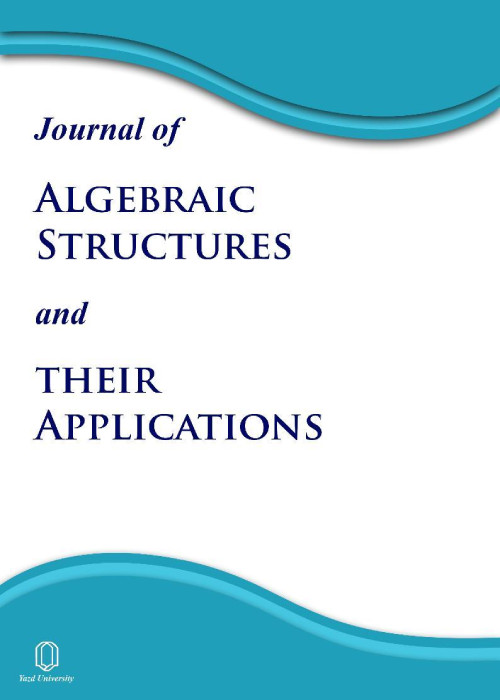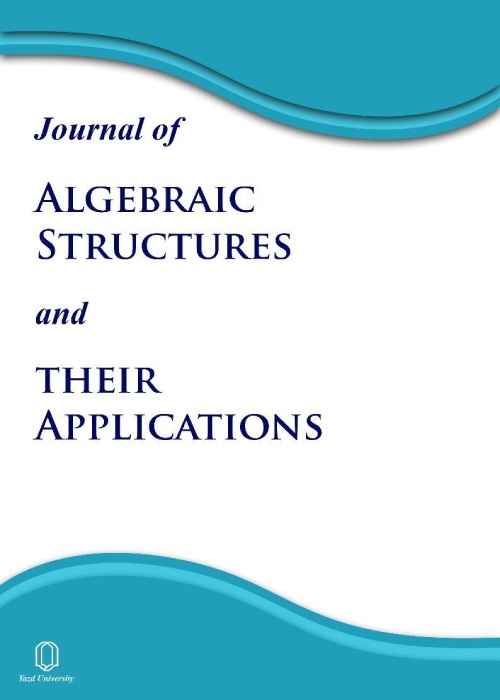فهرست مطالب

Journal of Algebraic Structures and Their Applications
Volume:10 Issue: 2, Summer-Autumn 2023
- تاریخ انتشار: 1402/05/10
- تعداد عناوین: 12
-
-
Pages 1-14It is well known that all subvarieties of the variety of all semigroups are not absolutely closed. So, it is worth to find subvarieties of the variety of all semigroups that are closed in itself or closed in the containing varieties of semigroups. We have gone through this open problem and able to determine that the varieties of right~[left] normal bands and left~[right] quasinormal bands are closed in the varieties of semigroups defined by the identities $axy = xa^ny~[axy = ay^nx],~axy = x^nay~[axy = ayx^n]$ $(n>1)$; and $axy=ax^nay$~$[axy=ayx^ny]$~ $(n>1)$, $axy=a^nxa^ry$ $[axy=ay^rxy^n]$ $(n,r\in \mathbb{N})$, respectively.Keywords: Band, Closed, Identity, Special semigroup amalgam, Variety, Zigzag equations
-
Pages 15-30The minimum edge dominating energy of a graph $G$ is defined as the sum of the absolute values of eigenvalues of the minimum edge dominating matrix of $G$. In this paper, for some finite symmetric groups $\Gamma$ and subset $S$ of $\Gamma$, the minimum edge dominating energy of the Cayley graph of the group $\Gamma$, denoted by $Cay(\Gamma, S)$, is investigated.Keywords: Cayley graph, Eigenvalue, Minimum edge dominating energy, Symmetric group
-
Pages 31-40The study of modules by properties of their endomorphisms has long been of interest. In this paper, we introduce the notion of jacobson weakly Hopfian modules. It is shown that over a ring $R$, every projective (free) $R$-module is jacobson weakly Hopfian if and only if $R$ has no nonzero semisimple projective $R$-module. Let $L$ be a module such that $L$ satisfies ascending chain conditions on jacobson-small submodules. Then it is shown that $L$ is jacobson weakly Hopfian. Some basic characterizations of projective jacobson weakly Hopfian modules are proved.Keywords: Hopfian modules, Jacobson weakly Hopfian modules, Weakly Hopfian modules
-
Pages 41-50A transitive subgroup $G\leq S_n$ is called a genus $g$ group if there exist non identity elements $x_1,...,x_r\in G$ satisfying $G=\langle x_1,x_2,...,x_r\rangle$, $\prod_{i=1}^r {x_i}=1$ and $\sum_{i=1}^r ind\, x_i=2(n+g-1)$. The Hurwitz space $\mathcal{H}^{in}_{r,g}(G)$ is the space of genus $g$ covers of the Riemann sphere $\mathbb{P}^1\mathbb{C}$ with $r$ branch points and the monodromy group $G$. Isomorphisms of such covers are in one to one correspondence with genus $g$ groups.In this article, we show that $G$ possesses genus one and two group if it is diagonal type and acts primitively on $\Omega$. Furthermore, we study the connectedness of the Hurwitz space $\mathcal{H}^{in}_{r,g}(G)$ for genus 1 and 2.Keywords: Braid Orbit, Genus $g$ System, Primitive Group
-
Pages 51-64In this article, we extend the concept of divisors to ideals of Noetherian rings, more generally, to submodules of finitely generated modules over Noetherian rings. For a submodule $N$ of a finitely generated module $M$ over a Noetherian ring, we say a submodule $K$ of $M$ is a regular divisor of $N$ in $M$ if $K$ occurs in a regular prime extension filtration of $M$ over $N$. We show that a submodule $N$ of $M$ has only a finite number of regular divisors in $M$. We also show that an ideal $\mathfrak b$ is a regular divisor of a non-zero ideal $\mathfrak a$ in a Dedekind domain $R$ if and only if $\mathfrak b$ contains $\mathfrak a$. We characterize regular divisors using some ordered sequences of prime ideals and study their various properties. Lastly, we formulate a method to compute the number of regular divisors of a submodule by solving a combinatorics problem.Keywords: Maximal independent subset, Partially ordered set, Prime ideal factorization, Regular divisors, Regular prime extension filtration
-
Pages 65-85The main objective of this study is to introduce Sheffer stroke R$_{0}-$algebra (for short, SR$_{0}-$ algebra). Then it is stated that the axiom system of a Sheffer stroke R$_{0}-$algebra is independent. It is indicated that every Sheffer stroke R$_{0}-$algebra is R$_{0}-$algebra but specific conditions are necessarily for the inverse. Afterward, various ideals of a Sheffer stroke R$_{0}-$algebra are defined, a congruence relation on a Sheffer stroke R$_{0}-$algebra is determined by the ideal and quotient Sheffer stroke R$_{0}-$algebra is built via this congruence relation. It is proved that quotient Sheffer stroke R$_{0}-$algebra constructed by a prime ideal of this algebra is totally ordered and the cardinality is less than or equals to 2. After all, important conclusions are obtained for totally ordered Sheffer stroke R$_{0}-$algebras by applying various properties of prime ideals.Keywords: Congruence relation, (prime) Ideal, (Sheffer stroke) R$, {0}-$algebra, Sheffer stroke
-
Pages 87-98A prime ring ${S}$ with the centre ${Z}$ and generalised derivations that meet certain algebraic identities is considered. Let's assume that $\Psi$ and $\Phi$ are two generalised derivations associated with $\psi$ and $\phi$ on ${S},$ respectively. In this article, we examine the following identities: (i) $\Psi(a)b-a\Phi(b)\in {Z},$ (ii) $\Psi(a)b-b\Phi(a)\in {Z},$ (iii) $\Psi(a)a-b\Phi(b)\in {Z},$ (iv) $\Psi(a)a-a\Phi(b)\in {Z},$ (v) $\Psi(a)a-b\Phi(a)\in {Z},$ for every $a, b\in {J},$ where ${J}$ is a non-zero two sided ideal of ${S}.$ We also provide an example to show that the condition of primeness imposed in the hypotheses of our results is essential.Keywords: Commutator, derivation, Extended Centroid, Generalized Derivation, Prime Ring
-
Pages 99-105We denote the integer $ \prod_{g \in G} o(g) $ by $\psi^{\prime}(G)$ where $o(g)$ denotes the order of $g \in G$ and $G$ is a finite group. In [14], it was proved that some finite simple group can be uniquely determined by its product of element orders. In this paper, we characterize ${\rm Alt}(5) \times \mathbb{Z}_p$, where $p \in \{ 17, 23\}$, by their product of element orders.Keywords: Finite group, Hall subgroup, Product of element orders, Solvable group
-
Pages 107-125The main goal of this paper is to introduce analogously modal operators on $L$-algebras and study their properties. To begin with, we introduce the notion of modal operators on $L$-algebras and investigate some important properties of this operator. In order for the kernel of modal operator to be ideal, we investigate what conditions are required. Relations between modal operator and endomorphism of $L$-algebras are investigated. Also, we define the concept of positive $L$-algebra and some characterizations of positive $L$-algebra are established. Finally, we introduce a map $k_{a}$ and show that $k_{a}$ is a modal operator and we prove that the set of all $k_{a}$ on a positive $L$-algebra makes a dual BCK-algebra.Keywords: BCK-algebra, $L$-algebra, Modal operator, Positive $L$-algebra
-
Pages 127-154The rings considered in this article are commutative with identity which are not integral domains. Let $R$ be a ring. An ideal $I$ of $R$ is said to be an annihilating ideal of $R$ if there exists $r\in R\backslash \{0\}$ such that $Ir = (0)$. Let $\mathbb{A}(R)$ denote the set of all annihilating ideals of $R$ and let $\mathbb{A}(R)^{*} = \mathbb{A}(R)\backslash \{(0)\}$. Recall that the annihilating-ideal graph of $R$, denoted by $\mathbb{AG}(R)$, is an undirected graph whose vertex set is $\mathbb{A}(R)^{*}$ and distinct vertices $I$ and $J$ are adjacent in this graph if and only if $IJ = (0)$. The aim of this article is to characterize zero-dimensional rings such that the clique number of their annihilating-ideal graphs is at most four.Keywords: Annihilating-ideal graph, Clique number, Special principal ideal ring, Zero-dimensional ring
-
Pages 155-172The notion of a (limited) commutative $T\&F$-ideal in BCK-algebras and BCI-algebras is introduced, and their properties are investigated. A relationship between a $T\&F$-ideal and a commutative $T\&F$-ideal in BCK-algebras and BCI-algebras is established, and examples to show that any $T\&F$-ideal may not be commutative are given. Proper conditions for a $T\&F$-ideal to be commutative are provided. Using a commutative ideal of a BCK-algebra and a BCI-algebra, a commutative $T\&F$-ideal is established. The closed $T\&F$-ideal in a BCI-algebra is introduced, and a condition for a closed $T\&F$-ideal to be commutative is discussed. Characterization of a commutative $T\&F$-ideal in a BCI-algebra is considered.Keywords: Closed $T, &F$-ideal, (limited) Commutative $T, &F$-ideal, (limited) $T, &F$-ideal, (limited) $T, &F$-subalgebra, $T, &F$-$, circ$-subalgebra, True-False structure
-
Pages 173-181
Let $R$ be a ring, $M$ a right $R$-module, and $S = End_R(M)$ the ring of all $R$-Endomorphisms of $M.$ We say that $M$ is Endomorphism $\delta$-$H$-supplemented (briefly, $E$-$\delta$-$H$-supplemented) provided that for every $\phi\in S,$ there exists a direct summand $D$ of $M$ such that $M = Im\phi + X$ if and only if $M = D + X$ for every submodule $X$ of $M$ with $M/X$ singular. In this paper, we prove that a non-$\delta$-cosingular module $M$ is $E$-$\delta$-$H$-supplemented if and only if $M$ is dual Rickart. We also show that every direct summand of a weak duo $E$-$\delta$-$H$-supplemented module inherits the property.
Keywords: Dual Rickart module, $, delta$-small-submodule, $E$-$, delta$-$H$-supplemented modules, $E$-$H$-supplemented module, $H$-supplemented module


